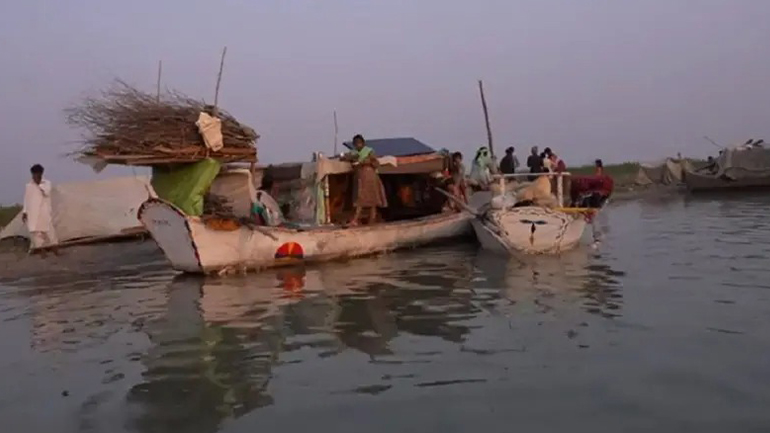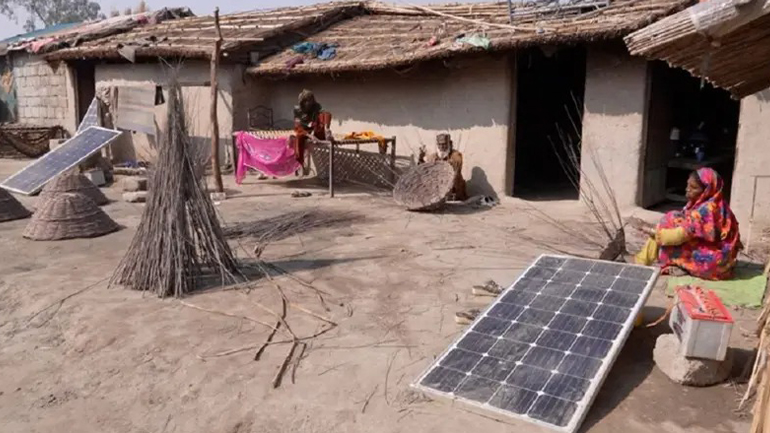

"Things used to be very good here, and the river had plenty of water. But now, the water is only limited to the barrage," said Bashiran Mai, a member of the Kehil community, one of the Adivasi tribes of Pakistan. "There used to be so many fish that our elders would fill boats with them, and trucks would be parked along the riverbanks to load the fish and take them to the market. Now, if we get even five kilos of fish in an entire day, we consider ourselves lucky. Sometimes, we even face days when we have nothing to eat. We work hard just to provide our children with at least a dry piece of bread." Bashiran Mai belongs to a river-based community that has lived for generations along the Indus River, particularly near the Taunsa Barrage. Known for their traditional fishing communities, these indigenous boat dwellers have long built traditional boat homes on wooden vessels, moving through river waters like nomadic river tribes. However, the impact of water shortage has changed everything. Due to climate change in Pakistan, including reduced rainfall, diminished snowfall on mountains, and the construction of barrages and canals, the River Indus is drying up. This has led to widespread drying rivers and displacement, forcing these displaced indigenous people to leave their ancestral homes and settle in nearby cities. Once a proud community with deep Sindhi River culture, they now face a water crisis in rural Pakistan, relying on labor or begging for survival. Despite the odds, Bashiran’s family has tried to maintain their connection to the river. Her husband owns a boat, and their family — around 8 to 10 people, including his brothers — still live on the water, embracing the life on wooden boats tradition. Near the Taunsa Barrage, a few boats remain as full-time homes. Women cook aboard these boats while the families keep livestock on the nearby banks. These floodplain communities still call themselves "Sindhi," holding on to their identity amid fading waters. A journey from Dera Ismail Khan to the Indus River's edge at Taunsa reveals the silent suffering of these people. As poet and Saraiki intellectual Ashu Lal says, "What has been done to the river has deeply affected a once-thriving, economically stable society." His poetry portrays the river as sacred — a symbol of life, nurturing, and identity. In one of his works, he calls the river the parents of its people and those who depend on it, “the children of the river.” This tragic transformation is a poignant example of Pakistan's climate migration, where ancient cultures and lifestyles are being lost to environmental change.
River, O River, your depths are vast,
You are our mother and father; we are your children.

The 'Kehl' community was famous for building their homes on wooden boats and moving from one place to another in river water for generations.
The people who have spent their entire lives living in boats on the Indus River are referred to in the Saraiki language as “Adivasi,” meaning indigenous people. This Adivasi tribe of Pakistan is an example of traditional river-based livelihoods that have sustained generations along the Indus River. In the past, this Kehil community lived entirely on boats in the Indus River, traveling from Hyderabad in Sindh province to Attock, a border city between Punjab and Khyber Pakhtunkhwa. However, due to decreasing rainfall, the construction of dams, barrages, and canals on the river, the community has lost its access to the river, forcing them into river-to-land migration. An organization called Save the Indus Movement (Sindhu Bachao Tarla) works for the welfare of these displaced river communities. According to Khadim Hussain, a member of this organization, “In the past, these indigenous river communities lived as a large group, sustaining themselves on boats and along the riverbanks. They fished in the Indus River for their consumption and to sell in the market. In addition, they were also involved in transporting people and goods across the river. Their entire life was connected to the river. They also depended on the nearby forests along the riverbanks, where women would gather shrubs and weave baskets and other goods to sell in cities.” According to Khadim Hussain, a survey conducted by their organization revealed that there are around 40,000 Adivasis living in the 250-kilometer stretch between the Chashma Barrage and Taunsa Barrage on the Indus River. “Some of them still live by the river, while others have been forced to live like nomads in cities.” With the construction of barrages and canals, not only was the natural flow of the river affected, but also, a system of fishing contracts (leased fishing rights) was introduced, disrupting the livelihoods of the Adivasi tribes. I belong to Dera Ismail Khan, a city in Khyber Pakhtunkhwa, and I remember that as a child, it was difficult to see the opposite bank of the Indus River from one side—the river was so wide. There was a time when the river held enough water for small cargo ships, launches, and large boats to operate. A ship called “SS Jhelum” sank about 30 years ago during a storm at the same spot on the Indus River. But now, the situation has completely changed, and the river resembles a narrow stream.

Due to the loss of employment in the river, members of this community are now forced to build their own homes in settlements.
In the outskirts of Dera Ismail Khan, near the dry riverbanks of Thoya Fazal, dozens of families from the Kehl Community live in tents and mud houses. These families are part of the Indigenous Communities of Sindh, whose traditional boat settlements along the Indus River were once their main way of life. The Indus River communities have long been dependent on the river for their livelihoods, but as the river dries up, the very foundation of their existence is under threat. The families residing here make a living by weaving baskets from shrubs and wood—a skill that has been passed down through generations. In the past, they used to collect the necessary wood and shrubs from the forests along the banks of the Indus River, but now, as the river dries up, the forests are also disappearing, and it has become increasingly difficult to find these materials. Safia Bibi’s hands have become as hard as those of men, and she has blisters on them. While weaving a basket, she told us that, due to the loss of other sources of income, her primary means of survival now depends on selling these baskets, and it requires a lot of hard work. “One basket will sell for around two hundred and fifty to three hundred rupees,” she explained. The Adivasi fishing practices that were once a major source of income for the Adivasis of the Indus River are now no longer a viable option, leaving them with few ways to earn a living. Safia Bibi shared that the work is very tough and causes the skin on her hands to crack. "The problem is that these shrubs are no longer available. There used to be forests, and there were shrubs, but now, people have started cultivating crops on the land where forests once stood." “We collect these shrubs, soak them in water, dry them, and then trim and shape them. Only then can we make baskets out of them,” she added. This traditional craft, once tied to the Kehl people's river dependency, now struggles to survive without access to the Indigenous river populations' original resources. Many people living here said that most women in their community now either work in people’s homes in nearby areas or beg to get by. The men also do some labor when they can, but often return home empty-handed. In the past, these families, who lived on boats along the river, were given land by local people to build their huts and mud rooms. “But in exchange for this land, we work in their homes and do manual labor. Sometimes we get paid, and sometimes we have to go without food.”
The indigenous communities of Pakistan, particularly the Kehl community or Adivasi tribes, are facing the devastating impact of a drying Indus River. Once dependent on the river for livelihood, these communities, including fishermen and boat dwellers, are witnessing the decline of their traditional boat settlements as the river dries up. The boats that once sailed across the Indus River now lie stranded on dry land, broken and deteriorating. The Kehl people, known for their river-based lifestyles, now face an uncertain future as the declining water levels have destroyed their traditional livelihoods. Muhammad Aslam, a resident of the area, shared his concerns about his broken boat. He explained, "Our ancestors used to benefit from this river; they could find work, and the boat business would thrive. But now, there is no water, and people don’t come here anymore." His story is one of many, where indigenous people are left to struggle as the dry river no longer supports the communities that once thrived along its banks. The Kehl community was historically known for fishing and transporting goods via boats, but with the drying up of the river, this community faces an existential crisis. Muhammad Aslam added, "In the past, our fathers used to catch fish, but now, if we manage to catch any, the contractors’ people come and fine us." These fishing communities have seen their source of income dramatically reduced, further exacerbated by the lack of rainfall and the water crisis. Asho Lal, a poet and intellectual from the Saraiki region, stated, "The life of the community living along the rivers is currently extremely difficult. Their life and well-being have not been given much attention. The drying river poses a threat to their traditional way of life, and at the same time, the nearby communities are also being impacted by climate change." As climate change continues to affect the region, these indigenous river populations are forced to adapt to a new way of living, one that no longer includes their historic relationship with the Indus River. With broken boats and dry rivers, the future of these communities is uncertain, and their river-based livelihoods continue to be endangered.
Powered by Froala Editor